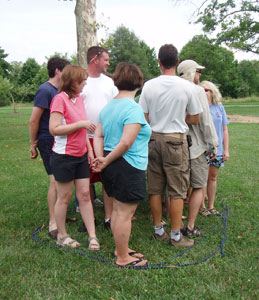Objectives
Students will understand how physical factors influence where an organism can live; students will understand how dead zones can lead to a decrease in the amount of suitable habitat available to aquatic organisms.
Materials
- Big open space (gym, field/courtyard)
- Length(s) of rope or tarp(s)
Procedure
- Lay out your tarp or make your rope into a large circle on the ground. Use additional tarps/ropes if you have a big group. You should make the space inside the tarp/rope big enough for everyone to fit inside with room to move around.
- Start out by explaining that each student is a rockfish/striped bass. Rockfish need dissolved oxygen in the water in order to “breathe” (respire) and they also prefer relatively cool water. The area inside the tarp/rope is cool oxygenated water. Any area outside the rope/tarp too hot or too low in oxygen for the rockfish to survive.
- Have all the students stand behind a designated boundary. When you say go, have them all find a spot inside the rope/tarp. For each round, everyone must get inside the rope/tarp, no exceptions! Everyone will easily find a spot the first round.
- Have students return to the boundary. Now start introducing various scenarios that can affect rockfish habitat conditions. Repeat rounds, each time decreasing the size of the rope or folding your tarp over some to make it harder to “squeeze” into suitable habitat. Ask the students each time how easy it was to find good habitat and how they feel crammed next to each other and discuss the factors that affect oxygen levels/habitat quality for each round.
Scenarios:
- First Round: Winter; the Bay is well mixed so no low oxygen areas and cold throughout. Plenty of room for everyone.
- Second Round: Late spring; Some phytoplankton from the spring bloom start to die and decompose; some areas of low oxygen form.
- Third Round: Summer, dry spring: Surface waters and shallows heat up and some parts of the deeper cool waters experience hypoxia as the moderate spring bloom decomposes and consumes oxygen, but not too bad.
- Fourth Round: Summer, wet spring: Surface waters and shallows heat up and a huge portion of the deeper cold water becomes hypoxic and even anoxic as massive spring blooms decompose, consuming lots of oxygen (make the tarp almost impossibly small.
- Fifth Round: Water cools during chilly autumn nights, mixing oxygen-rich water to the bottom to some extent. Make the tarp a little bigger.
- Fifth Round: Tropical storm mixes the bay, reoxygenating bottom waters. Really increase the habitat size.
*Note: this is also a great team-building exercise. This activity requires working together in close physical proximity in order to solve a practical, physical problem. It tends to emphasize group communication, cooperation, patience and problem solving strategy, as well as issues related to physical self and physical proximity.
Possible modifications: One teacher suggested running this activity in a classroom, where the space inside the rope/tarp represents the dead zone, rather than cool oxygen-rich water. Since a classroom is a confined space-like many estuaries-students are "squeezed" into the corners of the classroom as the dead zone area increases. Another teacher suggested describing each scenario and then have students create the rope/tarp space themselves.
National Science Education Standards
9-12 C: Life Science
- Interdependence of organisms
- Behavior of organisms
